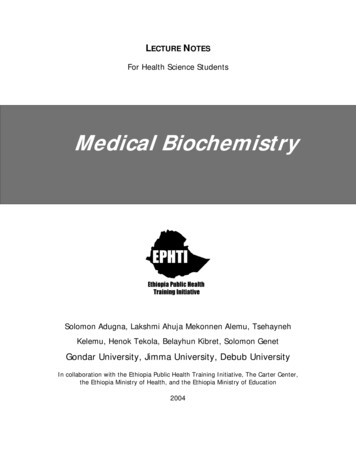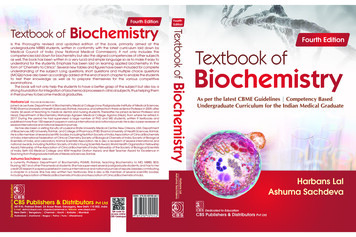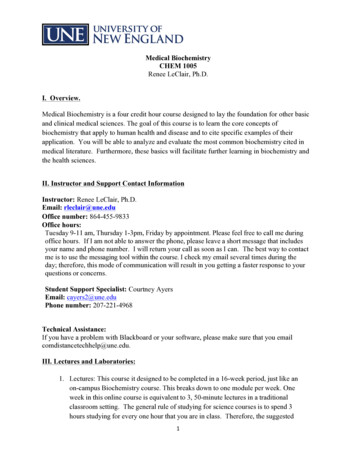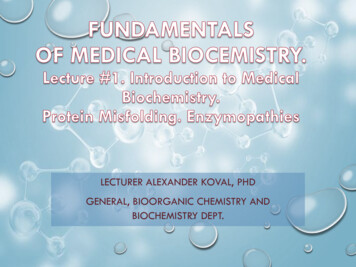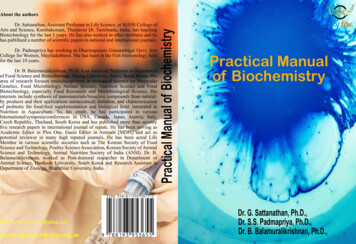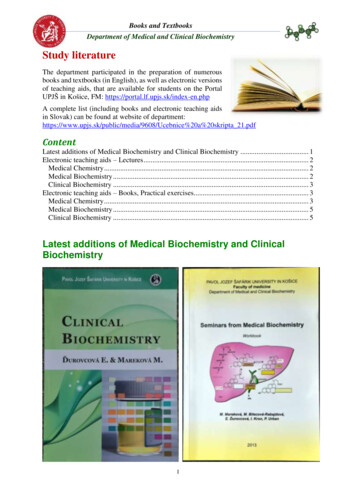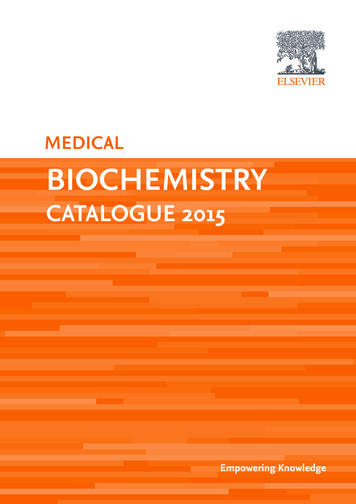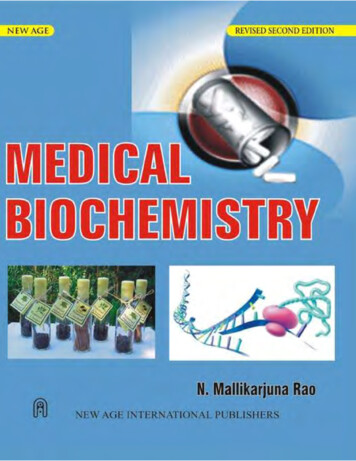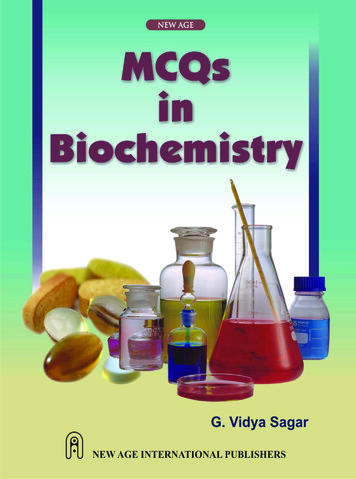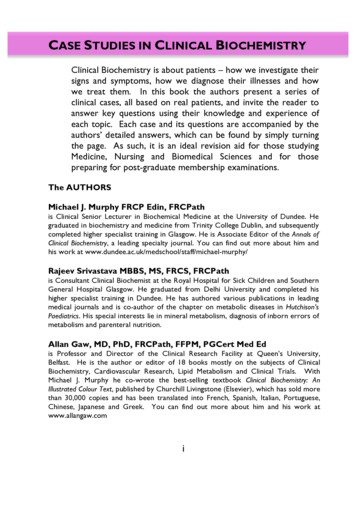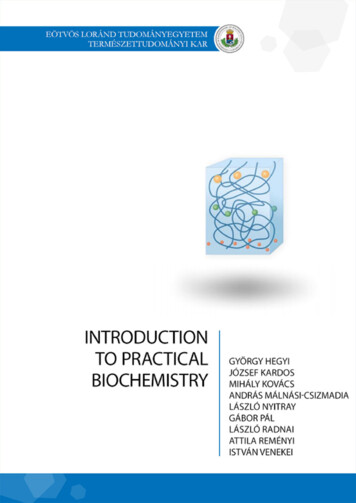
Transcription
Introduction to Practical BiochemistryGyörgy HegyiJózsef KardosMihály KovácsAndrás Málnási-CsizmadiaLászló NyitrayGábor PálLászló RadnaiAttila ReményiIstván Venekei
Introduction to Practical BiochemistryIntroduction to Practical Biochemistryby György Hegyi, József Kardos, Mihály Kovács, András Málnási-Csizmadia, László Nyitray,Gábor Pál, László Radnai, Attila Reményi, and István VenekeiCopyright 2013 ELTE Faculty of Natural Sciences, Institute of Biology2
Introduction to Practical BiochemistryTable of contentsForeword . 91. Common laboratory tools and equipment used in biochemistry and molecular biology . 111.1. Biological samples and chemical substances in the laboratory . 111.2. Plastic and glass tubes used for the storage of liquids . 111.3. Beakers and laboratory flasks . 151.4. Precise volumetric measurements with graduated cylinders and micropipettes . 171.5. Mixing of liquids . 211.6. Laboratory balances . 221.7. Methods of sterilisation and in-house production of high-purity water . 241.8. Working with cell cultures . 261.9. Centrifuges . 281.10. Other widely used laboratory techniques: spectrophotometry, electrophoresis,chromatography . 321.11. Storage of biological samples . 342. Units, solutions, dialysis. 382.1. About units . 382.2. Numeric expression of quantities . 392.2.1. The accuracy of numbers, significant figures . 392.2.2. Expression of large and small quantities: exponential and prefix forms . 392.3. About solutions . 412.3.1. Definition of solutions and their main characteristics . 412.3.2. Quantitative description of solutions, concentration units . 412.3.3. Preparation of solutions . 422.4. Dialysis . 442.4.1. The principle of dialysis . 442.4.2. Practical aspects and applications of dialysis . 453. Acid-base equilibria, pH, buffer systems . 473.1. Ionisation equilibria of acids and bases in aqueous solutions . 473
Introduction to Practical Biochemistry3.2. pH-stabilising acid-base systems (buffers) and the influence of pH on ionisation . 513.3. Measurement of the pH . 553.4. Demo calculations of charge and pI . 563.4.1. Demonstration that pI is the average of the pKa values of the carboxylic acid andamino groups of an amino acid lacking an ionisable group in its side chain . 563.4.2. Demonstration that the pI value of aspartic acid is the average of the pKa values of thetwo carboxylic acid groups in it . 583.4.3. Demo calculation of the isoelectric point of a protein . 614. Spectrophotometry and protein concentration measurements . 654.1. Photometry . 654.2. The UV-VIS photometer . 674.3. Other possible uses of photometry . 694.4. Frequently arising problems in photometry . 694.5. Determination of protein concentration . 704.5.1. Biuret test . 704.5.2. Lowry (Folin) protein assay . 704.5.3. Bradford protein assay . 714.5.4. Spectrophotometry based on UV absorption . 714.6. Spectrophotometry in practice: some examples . 724.6.1. Absorption spectrum of ATP . 724.6.2. Hyperchromicity of DNA . 724.6.3. Absorption spectra and molecular structure of NAD and NADH. 734.6.4. Absorption spectrum of proteins . 744.6.5. Determination of the purity of DNA and protein samples . 764.7. Fluorimetry . 774.7.1. Physical basis of fluorescence . 784.7.2. The fluorimeter . 784.7.3. Fluorophores . 804.8. Appendix . 854.8.1. Fluorescence, phosphorescence and chemiluminescence . 854.8.2. Photobleaching . 854
Introduction to Practical Biochemistry4.8.3. Fluorescence anisotropy and circular dichroism . 864.8.4. Quenching and FRET . 875. Cell disruption, cell fractionation and protein isolation . 895.1. Cell disruption . 895.2. Cell fractionation . 905.3. Centrifugation. 905.3.1. Differential centrifugation: cell fractionation based primarily on particle size . 935.3.2. Equilibrium density-gradient centrifugation: fractionation based on density . 955.4. Low-resolution, large-scale protein fractionation . 975.4.1. Fractionation methods based on solubility . 985.4.2. Protein fractionation based on particle size. 1035.5. Lyophilisation (freeze-drying) . 1046. Chromatographic methods . 1056.1. Gel filtration chromatography . 1096.2. Ion exchange chromatography . 1136.3. Hydrophobic interaction chromatography . 1176.4. Affinity chromatography . 1196.5. High performance (high pressure) liquid chromatography (HPLC) . 1247. Electrophoresis . 1297.1. Principles of electrophoresis . 1297.2. About gel electrophoresis . 1317.3. Polyacrylamide gel electrophoresis (PAGE). 1337.3.1. About the PAGE method in general . 1337.3.2. Native PAGE . 1387.3.3. SDS-PAGE . 1397.3.4. Isoelectric focusing . 1427.3.5. Two-dimensional (2D) electrophoresis . 1447.4. Agarose gel electrophoresis. 1467.5. Staining methods . 1467.5.1. General protein gel stains . 1465
Introduction to Practical Biochemistry7.5.2. General DNA gel stains. 1477.5.3. Specific protein detection methods: Western blot . 1477.5.4. Specific protein detection methods: In-gel method based on enzyme activity . 1487.6. Typical examples of protein-separating gel electrophoresis . 1507.6.1 Native PAGE separation and detection of lactate dehydrogenase isoenzymes. 1507.6.2. Molecular mass determination of myofibrillar proteins using SDS-PAGE . 1528. Protein-ligand interactions . 1568.1. Biomolecular interactions. 1568.2. Reaction kinetics . 1568.3. Protein-ligand interactions . 1588.4. Relationship between the free enthalpy (Gibbs free energy) change and the equilibriumconstant. 1588.5. Molecular forces stabilising ligand binding . 1608.6. Determination of the binding constant . 1638.7. Methods for the experimental determination of the binding constant. 1678.7.1. Surface plasmon resonance (SPR) . 1688.7.2. Isothermal titration calorimetry (ITC) . 1718.7.3. Fluorescence depolarisation to characterise protein-ligand binding interactions . 1728.8. Test questions and problems . 1749. Enzyme kinetics . 1759.1 Thermodynamic interpretation of enzyme catalysis . 1759.2. Michaelis-Menten kinetics . 1819.3 Determination of initial reaction rates and principal kinetic parameters . 1919.4. Enzyme inhibition mechanisms . 1959.4.1. Competitive inhibition. 1959.4.2. Uncompetitive inhibition. 1989.4.3. Mixed inhibition . 20010. Recombinant DNA technology . 20310.1. Recombinant DNA techniques and molecular cloning . 20310.2. Plasmid vectors . 20410.3. Creation of recombinant DNA constructs . 2066
Introduction to Practical Biochemistry10.4. Introduction of recombinant DNA constructs into host cells and the identification ofrecombinant colonies. 20910.5. Isolation of plasmid DNA . 21110.6. Analysis of plasmid DNA by gel electrophoresis . 21410.7. Polymerase chain reaction (PCR). 21810.8. Site directed in vitro mutagenesis . 22110.9. DNA sequencing . 22511. Bioinformatics . 23511.1. Introduction . 23511.2. Primary sequence and three-dimensional structure databases . 23611.2.1. GenBank . 23711.2.2. UniProt . 24111.2.3. Protein Data Bank (PDB) . 24311.3. Introduction to bioinformatics analysis of sequences . 24511.3.1. Bioinformatics tasks during molecular cloning . 24511.3.2. Sequence similarity search and sequence alignment . 24511.3.2.1. The BLAST program . 24511.3.2.2. Multiple sequence alignment . 24811.3.3. Bioinformatics analysis of protein sequences . 24811.4. Visualisation of protein structures by molecular graphics programs . 24911.4.1. RasMol . 24911.4.2. PyMOL . 25111.4.3. Jmol . 25212. Calculations and problem solving exercises . 25412.1. Useful preliminary information . 25412.2. Problems and exercises . 25512.2.1 Units of measure, solutions . 25512.2.2. Ionisation equilibria. 25812.2.3. Spectrophotometry of biomolecules. 26012.2.4. Cell disruption, cell fractionation and protein isolation . 26312.2.5. Peptides and proteins . 2647
Introduction to Practical Biochemistry12.2.6. Chromatographic methods . 26612.2.7. Electrophoretic methods . 26812.2.8. Protein-ligand interactions . 26912.2.9. Enzyme kinetics . 27012.2.10. Recombinant DNA technology . 27412.2.11. Bioinformatics . 27412.3. Solutions . 27512.3.1. Units of measure, solutions . 27512.3.2. Ionisation equilibria. 27612.3.3. Spectrophotometry of biomolecules. 27712.3.4. Cell disruption, cell fractionation and protein isolation . 27712.3.5. Peptides and proteins . 27812.3.6. Chromatographic methods . 27812.3.7. Electrophoretic methods . 27912.3.8. Protein-ligand interactions . 27912.3.9. Enzyme kinetics . 27912.3.10. Recombinant DNA technology . 28012.3.11. Bioinformatics . 28113. Epilogue . 2828
Introduction to Practical BiochemistryForewordby Attila ReményiThe ―Introduction to Practical Biochemistry‖ e-book is mainly intended for B.Sc. studentsstudying biology at Eötvös Loránd University. It is part of the course material for studentsattending the seminars run under the same title. As it covers a broad range of subjects on thebasic as well as the practical aspects of biochemical and molecular biological work, it is likelythat it will be also useful for any student attending different theoretical or practical biochemistrycourses. The course material builds on pre-existing knowledge obtained at previous B.Sc. coursesincluding General Chemistry, Physical Chemistry and Organic Chemistry. It assumes a solidbackground and experience in chemical calculations and the successful completion of the courseentitled ―Introduction to Biochemistry‖, which is taught as part of the Biology B.Sc. program atEötvös Loránd University, or that of another Biochemistry course at a similar level. The―Introduction to Biochemistry‖ e-book can be found here.The ―Introduction to Practical Biochemistry‖ seminar series will prepare students for moreadvanced courses including the lectures on ―Biochemistry and Molecular Biology‖, and it isparticularly indispensable for the third-year hands-on training course entitled ―Practicals inBiochemistry‖. The format of the course may be described as a ―practical seminar‖. This is amixture of the classical seminar where the theoretical principles are further discussedinteractively with students, and the classical practical where the same is accomplished byperforming experiments and analyzing experimental data in a first-hand manner. On practicalseminars, teachers present the basic principles of techniques broadly used in the biochemical andmolecular biological laboratory practice, make some demonstrations on different techniques andshow the use of some of the everyday laboratory instrumentation. We have put special emphasison presenting demonstrations and problem sets that will make the students face ―real-life‖laboratory situations. Problem sets and biochemical calculations are to be solved interactively,with students working in groups on finding the solution and the teacher being involved only as adiscussion moderator.The e-book is not the description of different biochemical practicals, and it does not containdetailed experimental protocols to perform experiments. It rather contains a collection anddescription of principles that will help the students perform successful biochemical and molecularbiological experiments on their own during their future carrier. The experience of the author teamgathered during five years of practice resulted in a course material that enables students toefficiently use hands-on practicals in biochemistry and molecular biology later during theirtraining. Moreover, the material also provides a solid background in biochemical calculations, aprerequisite for successful experimental design.The e-book covers the course material for a one-semester B.Sc. course delivered in three hoursper week. The course does not discuss all families of molecules that are subject to biochemicaland molecular biological investigation. It mainly deals with techniques used to study proteins andnucleic acids. The methods on carbohydrates and lipids are discussed as parts of OrganicChemistry courses, and they are also discussed in lectures on ―Biochemistry and MolecularBiology‖.9
Introduction to Practical BiochemistryBy completing the ―Introduction to Practical Biochemistry‖ course, students will acquirepractical knowledge regarding the techniques used to investigate the properties ofmacromolecules. As mentioned earlier, the course puts a great emphasis on demonstrating how tosolve ―real/life‖ tasks and problems faced by the investigator in biochemical and molecularbiological laboratories. Students will become familiar with commonly used labware andinstrumentation of a biochemical and molecular biological laboratory, learn the requirements forsterile work, and will be able to store biological samples properly. They learn how to correctlyuse biochemical units of measure and to make solutions and buffers for basic biochemicalexperiments. They will be able to determine the charge of weak acids, bases and macromoleculesby taking into account their chemical environment. They learn how to measure themacromolecular concentration of solutions by spectrophotometry. They will be able to designprotocols for the purification of proteins from cell cultures or tissues. They will become familiarwith the physico-chemical background of enzyme action and the fundamentals of enzymekinetics. They learn how to characterise the interaction between macromolecules and theirligands quantitatively. They will become familiar and be capable of using basic recombinantDNA techniques for nucleic acid manipulation and the production of proteins. They will be ableto use public bioinformatics databases to acquire information on the physical, chemical andbiological properties of macromolecules.The e-book comprises 11 chapters dealing with different topics. In addition, Chapter 12 containsmore than 100 simple and more complex problems enabling students to constantly put theirknowledge to a test by attempting to solve the problem sets belonging to specific chapters.The author team of the Department of Biochemistry at Eötvös Loránd University wishes thestudents and all readers an enjoyable experience in entering the field of biochemical andmolecular biological laboratory life!10
Introduction to Practical Biochemistry1. Common laboratory tools and equipment used inbiochemistry and molecular biologyby László RadnaiThe aims of biochemical and molecular biological research are complex and diverse.Investigation of the network of chemical reactions taking place in living organisms andrepresenting the most fundamental phenomena of life, identification of the molecules playingroles in biochemical processes, determination of their structure, function and interactions,examination of the molecular background of metabolism, the flow of energy and informationwithin organisms are all among the common goals of biochemists and molecular biologists. Inaccordance with this diversity of problems, a high variety of tools, instruments and methods arerequired to answer scientific questions effectively. This chapter reviews the most common toolsand instruments used very frequently in almost every laboratory. The appropriate handling andstorage of biological samples and other chemical substances required for research will also bediscussed.1.1. Biological samples and chemical substances in the laboratoryTissue or cell samples from a living organism, different cell cultures grown in a laboratoryincubator under controlled conditions, homogenates or extracts of cells and tissues, solutions ofisolated and purified components (e.g. proteins, nucleic acids) can all be referred to as ―biologicalsamples‖. As the medium of life is water, the majority of biological samples can be defined asaqueous solutions with one or more components, colloidal systems, or water-based suspensions(e.g. bacterial cells dispersed in a liquid medium). Consequently, most biochemical experimentsalso take place in aqueous environments. Therefore, laboratory vessels used to store liquids andlaboratory tools required for the manipulation, transfer and accurate volume measurements ofliquids will be introduced in this chapter. Different solids (e.g. chemical substances obtainedfrom different companies, synthetic oligonucleotides or peptides) are also often necessary forbiochemical research. In most cases, solids are dissolved in water (or sometimes in othersolvents) prior to the experiments. Therefore, the methods of preparing solutions and measuringaccurately the weight of the required solids will also be discussed below. Sometimes we usegases in the laboratory. These can be stored in gas cylinders (e.g. O2), in Dewar flasks in liquidstate (e.g. liquid nitrogen), or dissolved in water (e.g. HCl or NH3). By working with gases it isvery important to follow all safet
entitled ―Introduction to Biochemistry , which is taught as part of the Biology B.Sc. program at Eötvös Loránd University, or that of another Biochemistry course at a similar level. The ―Introduction to Biochemistry e-book can be found here. The ―Introduction to Practical Biochemistr
